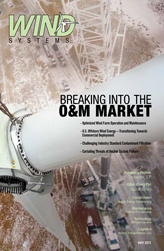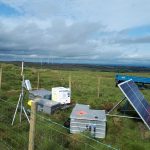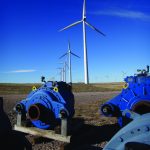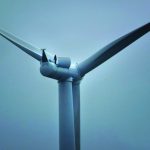On most wind turbines today, bearings outside of the main gearbox are lubricated with grease. Grease is typically pumped into a bearing with a grease gun, either manually or automatically. Other items such as open gear teeth are also protected with a layer of grease—applied by a brush, or automatic lubrication device. Applying this lubricant is fairly simple and is very successful in providing the necessary lubrication to bearings or gears.
For low-speed bearings, such as the blade pitch bearings and the main bearing(s) on the low speed shaft, grease is used to provide barrier lubrication to the mechanical components. This means that grease is used to coat the components so that the typically metal rollers and races don’t touch each other during movement. This allows components to work without suffering any wear during use. If the metal components become bare of the grease coating, metal-to-metal contact occurs, causing wear and potentially resulting in damage to component surfaces. Usually this damage results in scarring the surface of the rollers and races, and wear debris is generated. The debris may not fall away from the wear surfaces and can be held in place by the surrounding grease. This debris then can be run through and in between items that should be protected by the grease coating, and instead the debris is caught between the two mating surfaces causing more damage and more debris. This is kind of like getting a rock stuck in your shoe and causing pain to your foot. It just doesn’t belong there.
To prevent this from happening, you have to ensure to have enough grease in the mechanical device at all times. You also have to be careful when adding grease to the system not to introduce dirt or other contaminants into the lubrication system. This means that you must always be mindful when opening grease containers to not allow dirt from the ambient area to contaminate the exposed replacement grease. If you are pumping grease in with a standard grease gun, you must also always ensure that the grease fittings are wiped clean and that the grease gun application tip is clean. Usually it is good practice to discard the first pump from the grease gun to ensure that the grease at the tip of the gun is not contaminated. This helps to prevent introduction of contaminants during the maintenance service.
For all of you managers and owners, how do you know if your low speed bearings, such as your low speed shaft bearing(s), are being properly lubed? How do you know that the pitch bearings on your turbines are not being damaged due to insufficient barrier lubrication or contamination? The way to monitor the wear of these items is by collecting and performing “Grease Sample Analysis.”
Grease sampling of low-speed bearings protected by grease for barrier lubrication has been used in the wind energy since the beginning of our modern industry. Part of the U.S. Windpower 56/100 wind turbine maintenance is to take grease samples during the service from the turbine’s “free yaw” roller bearing. The grease samples are used to track the size and quantity of particles found in the sample over the life of the turbine. Grease samples are compared to previous samples, and to other turbine samples. Trending is done, and if the sample contains evidence of particles larger than considered acceptable, the bearing is scheduled for replacement. This collection of grease sample data helps to prevent surprises. For this type of turbine, the surprise that can happen is the failure of the bearing and the turbine coming off the top of the tower, unplanned, destroying the machine. The collection of grease samples is not a trivial pursuit.
Grease sampling of all low-speed bearings is something that all turbine owners and service providers should be performing. This is a fairly simple task and can be performed during the normal maintenance services without incurring that much more additional time to perform the service. It also helps to reinforce attention on the color and quantity of expelled grease from grease systems, which can also supply information as to the performance and health of the specific mechanical system.
These grease samples can be sent to a test center to be analyzed for wear debris. Usually the lab can determine if the wear particles from the grease sample are ferrous wear particles, non-ferrous wear particles, and if outside contaminants are present. The particles are classified for comparison. The analysis usually is supported by photographs, and is performed by experienced analyst.
Collecting and analyzing grease samples on a regular basis gives you the ability to spot trends or abnormalities that could potentially lead to equipment failure. This information allows you to make good decisions and reduces your chances of being broadsided by a surprise event. Remember, surprise events on a wind farm are rarely positive, and result in less production and expensive repairs.

































